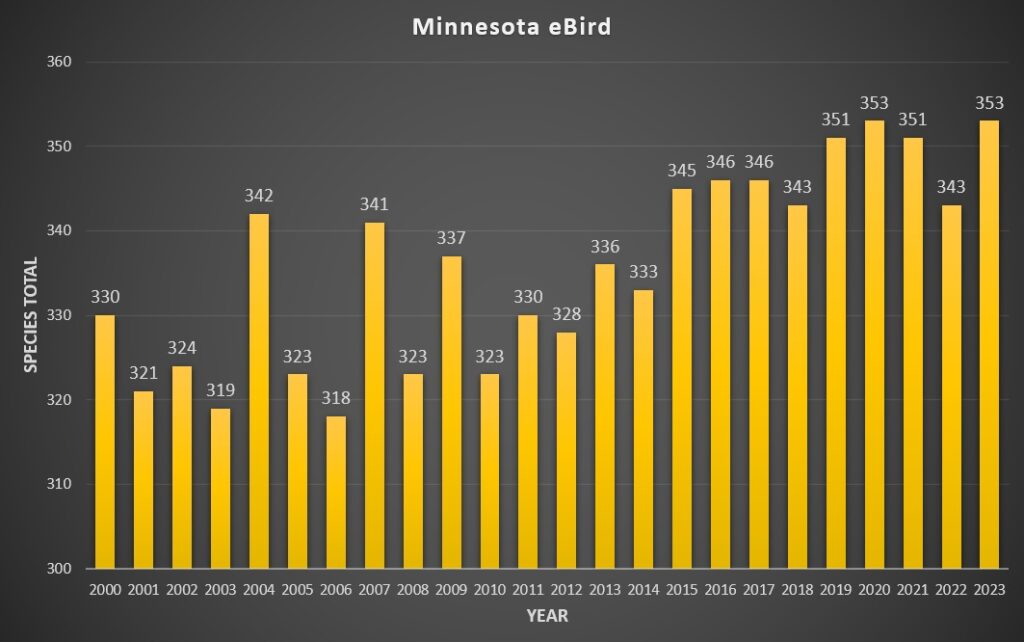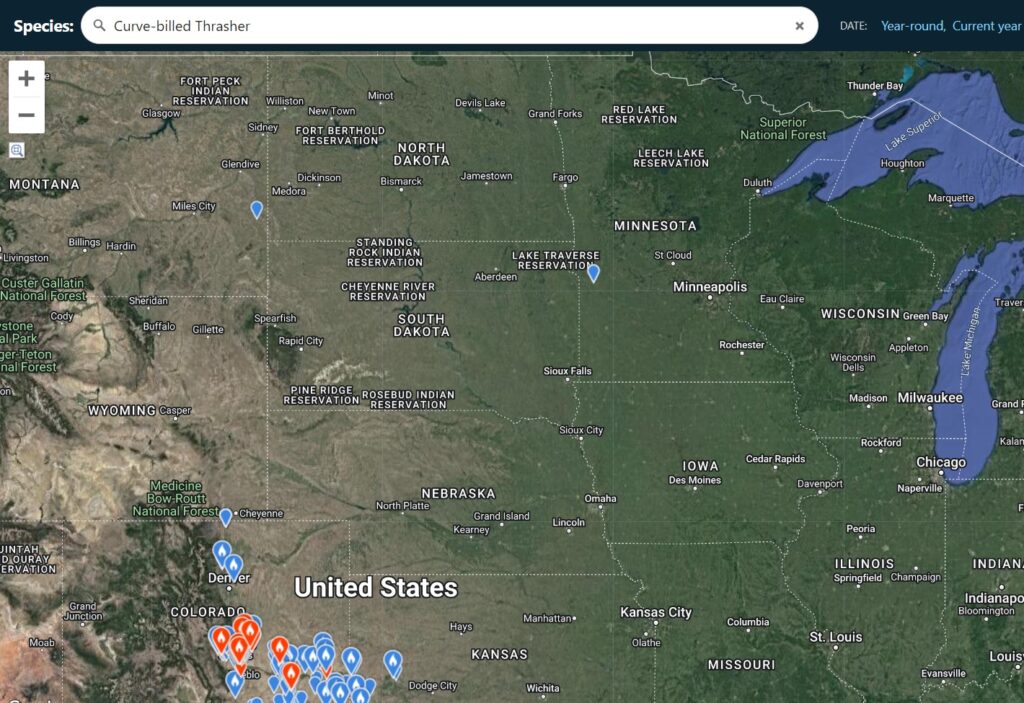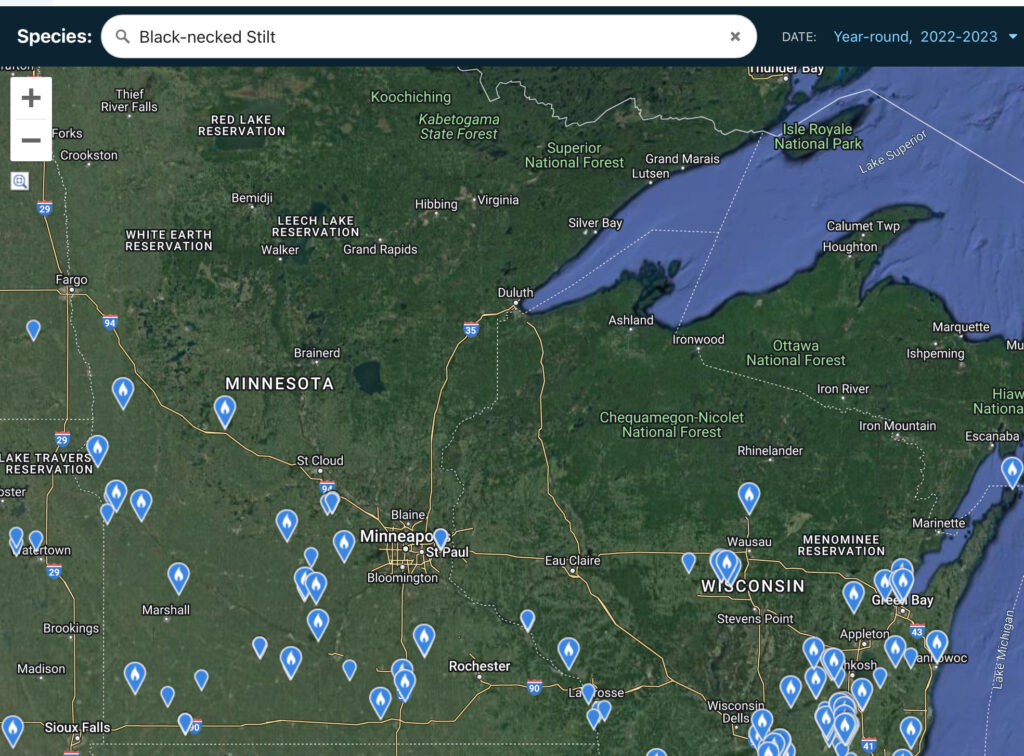Minnesota eBird 2023 Year in Review

eBird Stats
During 2023, Minnesota eBirders submitted more than 179,300 checklists and recorded 353 species tying with 2020 for the most species recorded in the state in a single year. The 10 year-average (2013-2022) is 345 species.
St. Louis County once again took the top spot in 2023 with 289 species reported within its borders, while Noble County was only able to muster 158 species for the year.
Five hotspots around the state were able to pull in 200 or more listed species: Bass Ponds (Hennepin); Park Point Recreation Area (St. Louis); Sherburne NWR Wildlife Drive (Sherburne); Old Cedar Avenue Bridge (Hennepin); and Carver Park Reserve–Grimm Rd. Picnic/Rec. Area (Carver).

Total Minnesota Species Reported to eBird by Year
Birds of 2023
In an above-average year for Minnesota by species count, the quality of species found was equally as awesome and inspiring. Potential trends continued to develop or gain clarity that we will delve into below as we cover the Casual and Accidental species that birders found in 2023. The Minnesota Ornithologists’ Union (MOU) definitions for the categories of Regular, Casual and Accidental species are provided below.*
- Regular Species: recorded in at least nine of the past ten years (313 species)
- Casual Species: recorded in fewer than nine of the past ten years but in more than two (41 species)
- Accidental Species: recorded in fewer than three of the past ten years (95 species)
It is always good to remember that these types of lists are helpful guides for relative rarity, but will inevitably lag behind a species’ current status as bird populations shift and change over time. It can take several years before enough data is available to reclassify birds that have become abundant enough to move into Regular status or down to Casual/Accidental status. Some of these possible edge species will be highlighted in this review where the author sees opportunity to do so, but the MOU Records Committee is the authority on such status changes spending many hours and years reviewing and voting on records of species and their status in the state.
January
The month of January kicked off with what we might consider our first edge species on its way from the Casual list to the Regular list. The first report in 2023 for Eurasian Tree Sparrow (Passer montanus) came on January 8 in Goodhue County, but it would be far from the last as a total of at least 10 counties had reports of this species during the year. This matches the number of counties reporting in 2022 and strengthening the conclusion that they are here to stay.
February/March
During the slowest months of the year, only a single species would raise the blood pressure of state birders as a Band-tailed Pigeon (Patagioenas fasciata) was photographed on February 6 in Winona County. Alas, only the original finder was able to spot and photograph this wonderful bird.
April
This month gave us quality audio for Barn Owl (Mareca penelope) in Houston County on April 7 followed by additional audio events in Steele and Isanti counties during the year. For a species that has had a very difficult road in Minnesota, these were much welcome events for those hoping they can once again gain a foothold in the state.
We were also treated to two sightings of Eurasian Wigeon (Mareca penelope) in April with an Anoka County sighting on the 10th and a long-staying record from Rice County starting on the 18th.
A Grant County Rock Wren (Salpinctes obsoletus) was a finder-only treat on the 13th. The bird perched and called from an old barn for a brief moment before taking off to better territory.
The state’s first Curve-billed Thrasher (Toxostoma curvirostre) reported since 2017 showed up in Big Stone County on April 22 in a homeowner’s yard and staying for a few days before moving on as well. You can see in the eBird map of sightings from this year how far this individual overshot its normal territory.

Curve-billed Thrasher Sightings Reported to eBird in 2023 (detail)
Perhaps our next species on the list of Casual birds trending towards Regular would be the Yellow-throated Warbler (Setophaga dominica). This species seems entrenched now in Houston County with the first sighting this year being from April 23 which follows 6 years of prior sightings from the same stretch of Reno Hillside Road. The species also picked up sightings in Dakota, Ramsey, and Olmsted counties during the year.
Yet another future candidate for the Regular list could be the Black-necked Stilt (Himantopus mexicanus). This species was once incredibly hard to find in the state, but in 2023 it was sighted in a minimum of 19 counties (12 counties in 2022)! It was practically an invasion and easy to forget it is still classified as Casual. Check the map below for the last two years of sightings across Minnesota to see where these long-legged shorebirds have been found.

Black-necked Stilt Sightings Reported to eBird in 2022-2023 (detail)
Glossy Ibis (Plegadis falcinellus) also had a wonderful showing this year with the first sighting in the state coming on April 23 in Pipestone County and bolstered by an additional 5 counties with sightings during the year.
One of the more eyebrow-raising spring rarities this year was word of multiple Burrowing Owls (Athene cunicularia) being spotted in the state. This former breeding bird and Regular species is now a state threatened species so it was exciting to hear about sightings in at least three counties with the first being on the 23rd in Brown County.
The last spotlight bird of April was the phenomenal first state record from Hennepin County of a Swainson’s Warbler (Limnothlypis swainsonii) found on the 29th. This bird dazzled for four days as hundreds of birders streamed by to get a peak at this specialty warbler from the Southeast part of the country.
These were not the only rarities for April though as the below species were also reported with California Gull showing well in three counties over the course of the year.
- Brambling (Fringilla montifringilla): Pine – 4/23/2023
- California Gull (Larus californicus): Clay – 4/24/2023 (also Stearns – 6/17/2023 and Crow Wing – 9/25/2023)
- Mountain Bluebird (Sialia currucoides): Clay – 4/28/2023
May
May kicked off with another wonderful warbler in the form of a Worm-eating Warbler (Helmitheros vermivorum) that was found skulking about in Hennepin County at the Bass Ponds area on the 1st of the month. This Casual level rarity was the first reported in the state in roughly 5 years and was seen for multiple days, allowing many to add it to their life lists.
It was actually a pretty intense year for rare warblers from both the Casual and Accidental lists as we were also briefly graced by the following birds around the state:
- Hermit Warbler (Setophaga occidentalis)(2): St. Louis 5/6, Ramsey 5/9
- Kentucky Warbler (Geothlypis formosa): Hennepin 5/8
- Prairie Warbler (Setophaga discolor): Ramsey 5/17
- MacGillivray’s Warbler (Geothlypis tolmiei): Le Sueur 9/9
Though it is important to note that not all reports will result in accepted records it is still remarkable that Minnesota may have had 7 total warbler species from the Casual and Accidental list in one calendar year including the Swainson’s that was not even on the state list.
In rapid-fire fashion the month of May is always a who’s who in rare birds and 2023 was no exception. We had Eurasian vagrants, dwindling northern migrants, and remarkable Arctic visitors. Below is a list of some of these rare sightings.
- Little Gull (Hydrocoloeus minutus): St. Louis 5/9
- Tufted Duck (Aythya fuligula): St. Louis 5/12
- Ruff (Calidris pugnax)(2): Stearns 5/12, Chippewa 8/22
- White-eyed Vireo (Vireo griseus): Lincoln 5/15, Rock 5/18
- Plumbeous Vireo (Vireo plumbeus): Anoka 5/16
- Red Knot (Calidris canutus): St. Louis 5/20, McLeod 5/25
- Lark Bunting (Calamospiza melanocorys): St. Louis 5/21
- Black Vulture (Coragyps atratus): Fillmore 5/22, Aitkin 6/18
- Arctic Tern (Sterna paradisaea): St. Louis 5/25
- Chuck-will’s Widow (Antrostomus carolinensis): Olmsted 5/30
- Mississippi Kite (Ictinia mississippiensis):
- Wilkin 5/17, Chippewa 5/18, St. Louis 8/22, St. Louis 9/4, Le Sueur 9/1
Even after that incredible lists of species, we still have more from the month to share including the below Painted Bunting (Passerina ciris) from Blue Earth County seen on May 7 that was one of two birds found in the state this year (Cook 6/22). This stunning adult male must have gotten in line three times when plumage colors were being handed out.
The western vagrant Lazuli Bunting (Passerina amoena) had a really good year in many states and Minnesota got in on the action with at least 3 total counties reporting this species including the one shown below from Morrison County on May 18.
Scissor-tailed Flycatcher (Tyrannus forficatus) gave us 4 different birds this year across 3 counties. Washington County gained not only its 1st county record, but later in the year its 2nd such record with the below bird that put on a show grabbing grasshoppers from its powerline perch.
A highlight gull for the year was a Ross’s Gull (Rhodostethia rosea) found on May 31 in St. Louis County. (Rudely the bird spent most of it’s time in Wisconsin.) Though one might get the impression considering the 2021 Ross’s Gull found in Washington County that they are a regular occurrence, it was just the 5th state record for this Arctic visitor and the 1st for St. Louis County. That last bit is astounding given that St. Louis County is pretty much the gull capital of the state.
Finally, the month of May also kicked off a continuing series of Limpkin (Aramus guarauna) sightings around the state. Perhaps no species is on a faster track from first state record to Casual species than the Limpkin. Prior to 2019, the range within the United States of this non-migratory wading bird was limited to the Florida peninsula and adjacent portions of Georgia. While an occasional vagrant was reported, in 2019 Limpkins exploded as far north as Ohio and moved west along the Gulf Coast to Louisiana. In 2023, they reached southern Canada and spread as far west as Colorado. It is thought that invasive species of large snails are quite literally fueling Limpkin range expansion. Minnesota’s first recorded Limpkin dropped into the Paul Hugo Farms Wildlife Management Area in Washington County in the summer of 2021. Another sighting followed in Olmsted County in 2022. It seemed that a Watonwan County bird first spotted on May 31 would be this year’s summer Limpkin, but while that bird was still being seen another individual appeared on the St. Croix River in Chisago County on June 18. Amazingly, by year end, seven counties added Limpkin to their records in 2023 (Clay 9/9, Jackson 9/25, Pine 10/24, St. Louis 10/29, Carlton 11/3).

June/July
From the MOU came a rare bird report in Lake County on June 9 of a Crested Caracara (Caracara plancus) and if that is a foreign name to you that might be because it was only the second one reported in state history according to the MOU’s database. (No eBird records for the state are known at this time.) That makes sense for a bird that is most often found in south Texas.
Black-legged Kittiwake (Rissa tridactyla), though relatively rare, made a great showing this year with two June records and then two more records in November (Cass 6/14, Beltrami 6/21, Cook 11/19, St. Louis 11/7). If that wasn’t enough the Cook sighting recorded two birds together.
August
A remarkable Swallow-tailed Kite (Elanoides forficatus) dazzled in Washington County on August 6. The only previous Washington County record for this species was from 1966. There was also a St. Louis County record at Hawk Ridge Bird Observatory in 2022.
For the fifth consecutive year a Neotropic Cormorant (Nannopterum brasilianum) was present at Richfield Lake Park in Hennepin County. This bird was first seen on August 10 this year adding yet another record to a really strange annual recurrence of an Accidental species at that exact park going back to 2019. Not to be outdone, the records committee will also have to review another potential record for the species out of Olmsted County from April 23 of this year.
On August 26, a Long-tailed Jaeger (Stercorarius longicaudus) was photographed in Cass County. This rarest of the three Jaeger species for the state, it is an exhilarating bird to see in flight as evidenced below. Alas it did not stick around long and was never seen again.
September
This month was definitely crazy with the finding of a first state record Royal Tern (Thalasseus maximus) in Washington County at the Stillwater Boom Site boat launch. The bird was found due to it acting different than the migrant Caspian Tern’s in the area along with calling with an obviously different voice. The bird tantalized state listers and played shadow games up and down the St. Croix River for days as it made seemingly random flights past locations like Carpenter Nature Center and Point Douglas. Some birders even reported the bird (or another) up the Mississippi River in Dakota County four days after the first identification.
Speaking of crazy, a report circulated around birding forums of a Western Sandpiper (Calidris mauri) seen on September 23 at Purgatory Creek in Hennepin County. The photos were solid and other birders went out to confirm and follow-up on the report. Though the bird was relocated, they almost immediately watched a Peregrine Falcon (Falco peregrinus) swoop out of the sky and take the sandpiper for a meal. It has been said before that Peregrine Falcon’s end more rare bird chases than any other species in the state. It is almost as if they are rare bird listers too, but use a much more brutal method of listing.
The month also included finds of Whooping Cranes (Grus americana) in Marshall County on September 12, and a bird feeder arrival of a Black-headed Grosbeak (Pheucticus melanocephalus) in Otter Tail County on September 18. Look at the chonky bill on that grosbeak species in the photo below.
It is worth noting the report of Whooping Crane is a great example of the value of a records committee and the work that they perform. This particular species is still in a very long recovery process that results in the nearest population (Wisconsin) not technically being considered wild since they were raised and managed by humans. As such the bar needed to gain an accepted wild record of the species is pretty high and doesn’t happen very often. Something similar happened many years ago with Trumpeter Swans needing many years for the population to be reestablished before their status could officially be moved to wild after human intervention.
October
A hoped for invasion of Clark’s Nutcracker (Nucifraga columbiana) did not materialize after they were found massing in historic numbers near the edge of their range west of Minnesota. However, video was shared on Facebook on October 8 of a lone bird spotted in Washington County near Stillwater. Many attempted to relocate this first county record without luck.
The month though did produce one of the year’s highlight birds in an Anna’s Hummingbird (Calypte anna) that showed up at a homeowner’s feeders in Dakota County on October 30 and stayed for an extended period of time. The homeowner invited all to view the bird and documented for multiple weeks the time it spent visiting feeders and picking at bugs in the garden.
November
The month of November kept up the pace of great birds as an apparent mid-continent invasion of Ancient Murrelet (Synthliboramphus antiquus) brought sightings to Minnesota and Wisconsin. In Minnesota, reports came in from three counties for a species that rarely gets one (Houston 11/9, Dakota 11/18, Lake 12/9). The most unfortunate aspect of this outbreak was that, even with 3 different counties/birds reported, barely a handful of birders were able to experience these wonderful Alcids as locations were either remote or the record was of a grounded and sick bird. The Lake County find was the most promising bird as it stuck around the Two Harbors area for a couple hours, but ultimately was only seen by a few birders.
A Sage Thrasher (Oreoscoptes montanus) also made an appearance in Minnesota this year with a very cooperative Ramsey County bird staying in the same area for at least 4 days beginning on November 13. This vagrant from the west was a nice way to spice up November and was actually found by the same person that found a Scissor-tailed Flycatcher in Washington County less than a month prior.
December
The most notable new rarity for the state in the month of December was a Yellow-billed Loon (Gavia adamsii) seemingly independently found by multiple parties on the 8th in Wabasha County. This follows a similar December record from Hennepin County in 2022. Conditions made it a tough bird to identify, but the photos seen thus far are promising for a confirmed record. Of additional interest was an adult male Barrow’s Goldeneye (Bucephala islandica) seen just upriver in Goodhue County making for a nice rare/uncommon bird combo.
We hope you enjoyed this review of Casual and Accidental species reported in Minnesota during 2023. Many thanks to the birders who document their sightings both through eBird and the MOU Request for Documentation Form. Good luck to all those birding in 2024 as we kick off another action-packed year of Minnesota birds!
*The Minnesota Ornithologists’ Union Records Committee. 2019. Checklist of the Birds of Minnesota. The Minnesota Ornithologists’ Union, Hastings, Minnesota.
